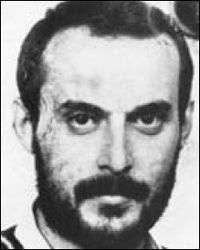Filippo Marchese
Filippo Marchese (11 September 1938 in Palermo – January 1983 in Palermo) was a leading figure in the Sicilian Mafia and a hitman suspected of dozens of homicides. Marchese was one of the most feared killers working for mafia boss Vincenzo Chiaracane, closely related to the Giuseppe Greco family which was in control of the Ciaculli neighbourhood of Palermo.
Filippo Marchese | |
|---|---|
 Filippo Marchese (undated photograph) | |
| Born | 11 September 1938 |
| Died | January 1983 (aged 44) Palermo, Italy |
| Nationality | Italian |
| Allegiance | Cosa Nostra |
| Criminal charge | Multiple murder |
| Penalty | Life imprisonment (sentence in absentia and post mortem) |
He was the boss of the Mafia family in the Corso dei Mille neighbourhood in Palermo.[1]
Room of Death
Marchese ran what became known as the Room of Death, a small apartment along the Piazza Sant Erasmo.[2] Victims who stood in the way of the Corleonesi, the Mafia clan from the town of Corleone, were lured there to be murdered, usually by being garrotted. Their bodies were either dissolved in acid or chopped up and dumped out at sea. As many as 100 people – mafiosi who stood in the way of the Corleonesi bosses, Salvatore Riina and Bernardo Provenzano, and their associates – were killed there during the Second Mafia War.
Vincenzo Sinagra
Like most mafiosi, Filippo Marchese was very elusive, and the primary source of information about his career in crime comes from Vincenzo Sinagra, an informant.[2] Sinagra was not a member of the Mafia but just a common criminal who, in 1981, made the mistake of stealing from a mafioso. He was given three choices; leave Sicily, die or become a gofer for the Corleonesi. He opted for the third option and ended up working with Marchese in the Room of Death.
Sinagra was arrested on August 11, 1982 when he was caught red-handed carrying out a contract killing, and after a year in custody he decided to become an informant and cooperated with the anti-Mafia judge Paolo Borsellino.[2] He testified at the Maxi Trial of 1986-87, along with Tommaso Buscetta. Sinagra claimed at the Maxi Trial that it was invariably his job to hold the feet of those who died in the Room of Death while Marchese strangled them with a length of rope. Sinagra even claimed that Marchese masturbated whilst snorting cocaine and watching victims being tortured. By the time of the Maxi Trial, however, Filippo Marchese was dead.
Downfall
Marchese had been a valuable asset to the Corleonesi during the Second Mafia War in 1981-83. Afterwards his violent nature was of no further use, and potentially marked him out as a threat to the leadership of the Corleonesi bosses, Salvatore Riina and Bernardo Provenzano. Sometime around January 1983, Filippo Marchese was garrotted and like so many of his own victims, subsequently dissolved in acid. He was so elusive that the authorities did not learn of his death until the late 1980s through an informant.
The man who killed Marchese was Pino Greco. Greco himself was killed in 1985 by two of his own men on Toto Riina's orders, his underboss Vincenzo Puccio and a lieutenant, Giuseppe Lucchese, who later became boss of the Brancaccio-Ciaculli mandamento after Puccio was killed.
Family and relatives
Filippo Marchese's two nephews, Antonino and Giuseppe Marchese, subsequently murdered Vincenzo Puccio in 1989 on Riina's orders, but then Riina deliberately destroyed their alibi. Giuseppe Marchese became a pentito in September 1992 after he realized his godfather and mentor Riina had betrayed him.
Marchese’s niece, Vincenza Marchese, was married to Leoluca Bagarella of the Corleonesi clan and Totò Riina's brother-in-law. Bagarella was rumoured to have killed his wife Vincenza sometime after her brother Giuseppe Marchese co-operated with the government and became a pentito (informant). When Bagarella was arrested on June 24, 1995 – after four years on the run with his wife –there was no sign of Vincenza, just a bunch of flowers in front of her picture on the mantelpiece – a sign of mourning. However, other sources said that Vincenza had committed suicide after her brother began collaborating with authorities. Another version was that she was clinically depressed, after a series of miscarriages. She had left a letter declaring her shame and asking her husband for forgiveness.[3]
References
- (in Italian) Sentenza nei confronti di Dell’Utri Marcello e Cinà Gaetano Archived 2007-09-28 at the Wayback Machine December 11, 2004
- (in Italian) Corso dei Mille, il più feroce dei clan, La Repubblica, October 20, 1984
- Longrigg, Mafia Women, p. 122
- Dickie, John (2004). Cosa Nostra. A history of the Sicilian Mafia, London: Coronet, ISBN 0-340-82435-2
- Jamieson, Alison (2000), The Antimafia. Italy’s Fight Against Organized Crime, London: MacMillan Press ISBN 0-333-80158-X
- Longrigg, Clare (1998). Mafia Women, London: Vintage ISBN 0-09-959171-5
- Stille, Alexander (1995). Excellent Cadavers. The Mafia and the Death of the First Italian Republic, London: Vintage ISBN 0-09-959491-9